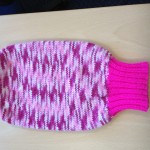By Helen King (W&M Regular Contributor)
(this post develops an earlier version that first appeared in July 2013 on http://departu.org.uk)
It was one of those moments that only happens when academics and practitioners are in the same room…
For about a year, I had been thinking about the history of visual representations of body parts, and had been introducing audiences in the UK and beyond to some of the knitting patterns available to make a womb. On knitty.com, for example, you can find a pattern from the amazing M.K. Carroll which allows anyone with needles and some bright pink wool to make a ‘cuddly’ womb with pipe-cleaner fallopian tubes and ovaries. If you think I’m making this up, look here.
M.K. Carroll took classes in anatomy and physiology which informed her work. But as she points out on the website, her knitted womb is ‘not completely anatomically accurate’. I was interested in two things here. First, the effect of knitting on making body parts look less terrifying and more ‘cuddly’, which is part of a wider movement in contemporary art towards knitting things that one would not normally associate with this medium; for example, cars. Second, the choice of what to include in ‘a womb’. In M.K. Carroll’s womb, tubes and ovaries and cervix are all important, and the cervix needs to ‘look plump (“pouty”, if you will)’.
I mentioned this to the other members of the De Partu history of childbirth research group, expecting the usual surprised response. Instead, they were not thrown in the slightest. ‘Oh yes’, they said, ‘we all know about knitted wombs. We have them, and we make them. They are very useful in parentcraft classes. Would you like us to show you our wombs?’
My jaw dropped. And once I saw the wombs, I was even more amazed and delighted. Firstly, because these wombs are not always brightly colored – in fact, one of the 1960s patterns that was kindly supplied to me by Lynn Balmforth, the librarian of the National Childbirth Trust, makes it explicit that these should be made in neutral, non-scary, colors, to make the effect more ‘acceptable’. Nor are they supposed to be ‘lifelike’. And secondly, because these wombs don’t bother with the ovaries and tubes – irrelevant by this stage of the proceedings! – but focus on the size of the gravid uterus and on the role of the cervix. They are used to show how contractions work and how the cervix dilates. A ball, representing the head, is pushed through the cervix and a ribbon through the external os can be used to control this.
This photograph was sent to me by Sue Tully, who is a Senior Lecturer in Midwifery at Bournemouth University; it gives you the general idea, although this one contravenes the 1960s guidelines on color schemes! So does the one described in the aftermath of the birth of Prince George last month; the Guardian journalist Suzanne Moore mentioned the advice she had received in an ante-natal class from a French midwife who saw no problem with drinking wine with dinner, and compared it unfavourably with ‘the usual midwife, who had knitted a uterus. She apologised for the fact that it was navy blue as she had run out of pink wool. The plain knit was the uterus and the ribbed sock bit was the cervix. She then proceeded to push a tennis ball through it. That, she said, was “birth”‘ (my thanks to Catherine Ebenezer for this reference!). Blue is also the colour used for the ‘cabbage patch doll’ both described and illustrated in a knitting forum discussion I found.
If you have any images of knitted wombs or information on how they have been, or still are, used around the world, I’d love to receive them.

